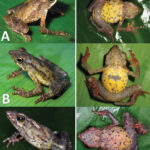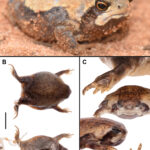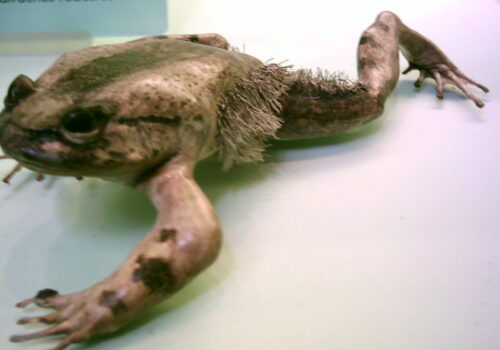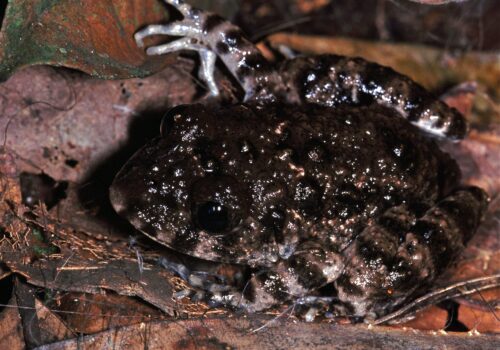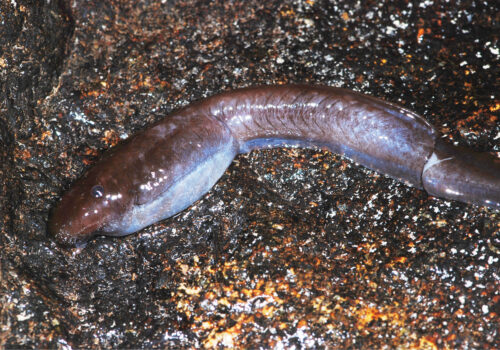- Introduction: A Hidden Jewel of the African Rainforest Floor
- Taxonomy and Classification: Understanding Arthroleptis brevipes' Place in the Frog Family Tree
- Natural Habitat: Life Beneath the Leaf Litter
- Physical Characteristics: Tiny, Cryptic, and Perfectly Adapted
- Behavior and Life Cycle: An Intriguing Terrestrial Existence
- Ecological Role: An Essential Link in the Rainforest Food Web
- Threats and Conservation Status: Navigating a Challenging Future
- Cultural and Scientific Significance: A Small Frog's Big Contributions
- Conclusion: Conserving an Amphibian Treasure
Introduction: A Hidden Jewel of the African Rainforest Floor#
Deep beneath the lush canopy of Africa’s equatorial forests hides Arthroleptis brevipes, a small and elusive amphibian known more simply as a squeaker frog due to its distinctive, birdlike chirping calls. These diminutive frogs, barely larger than your thumbnail, occupy critical places within the intricate tapestry of life in their rainforest habitats. Despite their tiny stature and secretive ways, Arthroleptis brevipes captivates biologists and naturalists alike with its fascinating adaptations, mysterious behaviors, and crucial ecological role.
Scientifically classified within the family Arthroleptidae, the brevipes species showcases remarkable evolutionary adaptations uniquely suited to life in leaf litter and forest undergrowth. Hidden from the watchful eyes of predators and casual observers alike, these frogs quietly contribute to their ecosystem’s health, serving as both predators of insects and prey to larger animals. Join us as we journey into their secretive world, uncovering the biology, behaviors, and delicate balance of conservation facing Arthroleptis brevipes.
Taxonomy and Classification: Understanding Arthroleptis brevipes’ Place in the Frog Family Tree#
Belonging to the amphibian order Anura, Arthroleptis brevipes falls within the family Arthroleptidae, a fascinating group often collectively called squeaker frogs. The genus Arthroleptis comprises numerous small-bodied frogs, many of which are easily overlooked due to their cryptic lifestyles and subtle colors. Within this genus, Arthroleptis brevipes distinguishes itself with particular physiological and ecological traits uniquely adapted to its dense forest habitats.
In scientific naming traditions, “brevipes” translates roughly to “short-footed,” an apt description distinguishing it from related species by its relatively shorter limbs and reduced digits. While closely related to other Arthroleptis species, Arthroleptis brevipes is identified by subtle morphological differences confirmed through intricate taxonomic analyses, including body size, limb proportions, and vocalization patterns. Understanding this taxonomy reveals evolutionary clues to the species’ specialized habits, habitats, and coexistence with other forest-dwelling amphibians.
Natural Habitat: Life Beneath the Leaf Litter#
Arthroleptis brevipes inhabits the humid, tropical rainforests of Central and West Africa, including regions in Cameroon, Equatorial Guinea, Gabon, and Congo-Brazzaville. Here, nestled in constant-shadowed patches of leaf litter among towering trees, decomposing logs, and thick mats of moss, these amphibians have evolved remarkable camouflage and secretive habits. Rarely venturing far from the safety of moisture-rich microhabitats, Arthroleptis brevipes thrives close to the forest floor, seldom ascending beyond logs or lower vegetation.
The rainforest habitat provides an ideal microclimate characterized by high humidity, stable temperatures, and dense organic matter that sustains the frog’s prey base. These frogs rely primarily on dense litter layers for protection from predators and dehydration, exploiting the abundant nutritional sources like termites, ants, springtails, and other tiny soil-dwelling invertebrates. Remarkably adapted for terrestrial life, Arthroleptis brevipes exemplifies a perfect evolutionary strategy: thriving unseen, undisturbed, and attuned to their leaf-strewn environment.
Physical Characteristics: Tiny, Cryptic, and Perfectly Adapted#
Arthroleptis brevipes ranks amongst Africa’s smallest frogs, typically measuring between 15 to 25 millimeters in length. Their small size significantly contributes to their elusive nature, allowing them to easily blend within their leaf-litter habitat. The coloration of these frogs differs slightly across their geographical ranges but generally encompasses shades of brown, tan, and olive with subtle but effective patterns that mimic dead leaves, twigs, and soil particles.
Close examination reveals subtle markings including darker bands, mottling, or flecks that obscure their silhouettes remarkably well against the forest substrate. Short limbs and reduced digit length create their characteristic “short-footed” appearance, enabling agile, low-profile hopping movements essential for swiftly navigating undergrowth when fleeing predators or pursuing prey.
A notable adaptation in Arthroleptis brevipes is the absence of webbing between its toes, underscoring its highly terrestrial nature. Unlike many frogs reliant on aquatic environments, this terrestrial lifestyle adaptation increases its survival probability by limiting predator encounters in open-water habitats and allowing rapid, precise movement amidst dense vegetation and leaf litter.
Behavior and Life Cycle: An Intriguing Terrestrial Existence#
A Diet of Tiny Delicacies#
Arthroleptis brevipes is predominantly insectivorous, feeding on a diverse diet of ants, termites, mites, springtails, and other minute insects abundant in their habitat’s moist litter environment. Equipped with keen eyesight and remarkable agility, these frogs rapidly and efficiently seize prey using their quick and precise movements. Predominantly nocturnal, they’re most active at dusk and nighttime, capitalizing on cooler temperatures, higher humidity, and reduced predation risks.
Unique Reproductive Strategies#
Unlike many counterparts reliant on aquatic reproduction, Arthroleptis brevipes practices direct development—an impressive adaptation allowing the species to lay terrestrial eggs capable of developing directly into froglets without an aquatic tadpole stage. The female lays small clutch sizes of eggs cleverly concealed beneath leaf litter, logs or within moist, protected areas adequate for embryo growth. From these eggs, fully formed miniature froglets emerge directly, an unusual reproductive strategy reducing the risk of aquatic predation and environmental challenges faced by vulnerable tadpoles.
Ecological Role: An Essential Link in the Rainforest Food Web#
In their ecosystem, Arthroleptis brevipes represents both prey and predator. Through consumption of numerous insects and arthropods, these frogs help regulate insect populations, indirectly controlling forest health by managing trophic cascades. As prey, Arthroleptis brevipes sustains larger predators, including snakes, lizards, spiders, birds, and mammals, forming an integral link maintaining balance and harmony in rainforest ecosystems.
In addition, as amphibians, these frogs serve as vital bio-indicators; their population dynamics and overall health mirror broader environmental changes, including pollution, habitat degradation, and climate shifts. Monitoring Arthroleptis brevipes populations can thus inform conservationists of habitat integrity and overall ecosystem resilience and stability.
Threats and Conservation Status: Navigating a Challenging Future#
The International Union for the Conservation of Nature (IUCN) currently lists Arthroleptis brevipes as Least Concern. However, a classification of Least Concern does not eliminate concern entirely. Fragmentation and loss of rainforest habitats through logging, agricultural expansion, infrastructure development, and urbanization present real threats to Arthroleptis brevipes’ future viability. Additionally, climate fluctuations and invasive species introductions may compel them to modify previously stable habits, affecting predator-prey interactions, reproductive success, and population health.
Conservationists advocate ongoing habitat management practices, including protected-area establishment, improved sustainable logging practices, and educational programs aimed at raising awareness about delicate amphibians’ ecological importance. Enthusiasts and researchers alike stress the importance of continued habitat preservation to prevent slipping into higher-risk conservation categories in coming decades.
Cultural and Scientific Significance: A Small Frog’s Big Contributions#
Traditional local cultures historically share diverse perceptions surrounding Arthroleptis species. Although specific cultural symbolism attached to brevipes specifically is scarce, its relatives within Arthroleptis are frequently revered or considered indicators of rainfall, seasonality, and forest health.
Scientifically, Arthroleptis brevipes provides researchers valuable opportunities for studying amphibian ecology, direct development evolution, and biological responses to environmental change, illuminating adaptive strategies applicable to broader conservation and ecological understanding.
Conclusion: Conserving an Amphibian Treasure#
Small, secretive, and remarkably adapted, Arthroleptis brevipes plays a critical yet often overlooked role in Africa’s rainforest ecosystems. Safeguarding the habitat supporting these fascinating frogs is crucial—not only to protect them, but also to preserve the complex diversity that enriches our world.
By learning about and appreciating species like Arthroleptis brevipes, we heighten awareness, foster stewardship, and encourage global efforts toward preserving forests, biodiversity, and the intricate web of life to which we all belong. So, as we pause to celebrate the hidden jewel that is Arthroleptis brevipes, let us remember our collective responsibility to protect and nurture the astounding natural diversity entrusted to our care.


